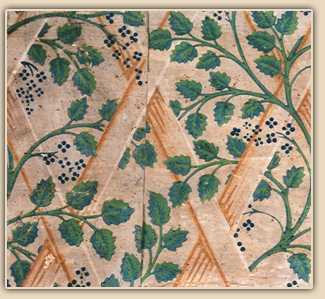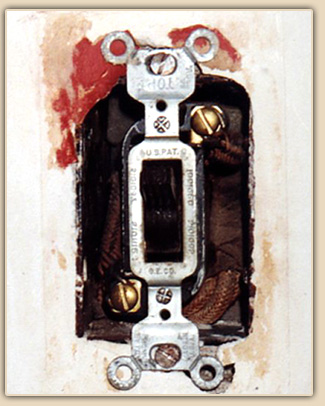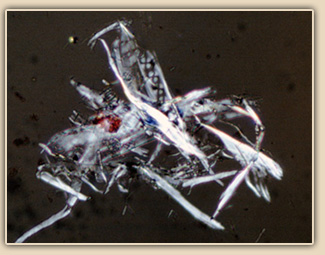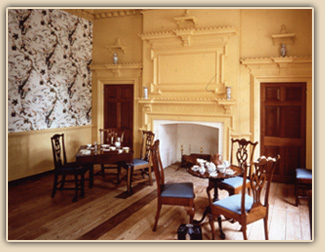|
Wallpaper Analysis :: |
|
|
|
Over the past two decades, awareness of the extensive use of wallpapers in American homes from the 18th through the middle of the 20th centuries has increased dramatically. This is likely a result of the ever-increasing number of sites being restored. Frequently, in the course of restoration, the investigation and analysis of historic paint finishes reveals evidence for the use of wallpaper. In the mid 20th century, while there was a strong emphasis on the study of original paint colors, minimal effort was devoted to the investigation and analysis of historic wallpapers. |
|
|
|
In fact, during the restoration of many museum houses, the plaster walls and ceilings were completely removed with little consideration for potential wallpaper evidence and its cultural significance. The paint colors used on the wood trim were of primary interest in these restorations. In contrast to past decades, the search for wallpaper evidence is now an essential part of the comprehensive finishes investigation of an 18th, 19th or 20th century house. Wallpaper from any period in a building's history shares an equal level of significance with paint. |
|
|
|
Wallpapers, like water-soluble distemper paints, are ephemeral in nature; they can be washed or scraped off the walls with little, if any, trace evidence left behind. Due to the ease and frequency of wallpaper removal, evidence is elusive. Therefore, consideration must be given to identifying and investigating key locations within a house where one is most likely to find fragments or fibers of old paper or evidence of adhesives used to affix a paper to the walls or ceilings. Examples of such locations include areas behind radiators or light switch coverplates, in closets or service passages, in shutter pockets, and even on the top, side or bottom edges of door and window architraves. Only occasionally did a homeowner repaper over existing paper, consequently preserving valuable evidence for evaluation and analysis. |
|
|
|
Once wallpaper evidence is collected, be it a large fragment or just a few fibers, the analytical and authentication process (i.e. the evaluation of age) begins. Until recently, wallpaper authentication was based primarily on design history, without sufficient utilization of the analytical process to determine the fiber composition of the paper and the pigment and binder composition of associated paints or inks. With the ultimate goals of authentication, scholarship and reproduction, the complex interpretation of historic wallpaper evidence requires individuals with overlapping expertise in the history of wallpaper design and manufacturing and in the microanalysis of wallpaper and paint materials. |
|
|
|
In order to have reliable expectations for wallpaper usage for a particular building, era and region of the country, the wallpaper historian is challenged with developing a comprehensive knowledge of 200 years of styles and designs popular in America. This accumulated knowledge builds from scholarship on the history of manufacturing processes, trade history with European sources, and primary source material found in houses. The wallpaper analyst similarly is challenged with developing knowledge of fiber production, the history and processes of paper and wallpaper manufacturing, and printing techniques that employ paints and inks. The analyst must also develop microanalytical skills for identifying natural and man-made fibers, paper binders, wallpaper adhesives, pigments, vehicles and potentially color, if the paper is authenticated as a candidate for reproduction. For both the design historian and the analyst, a comprehensive bibliography of reference sources is essential because there is so much critical information to evaluate in the authentication process. Caution is always prudent, however; older wallpaper and pigment reference material may not be fully up-to-date and inclusive of recent scholarship. |
|
|
|
At Frank S. Welsh [Welsh Color & Conservation], the stereomicroscope and the polarized light microscope (PLM) are the principal tools in the analytical process. Scanning electron microscopy and infrared spectroscopy also are employed on occasion. The identification of fibers or pigments that were not commercially available before specific dates provides critical benchmarks to aid the authentication process. PLM is the most useful tool for the analysis of these materials. As experienced microscopists, we can readily distinguish paper fibers like cotton, flax and wood, starch binders, paint pigments such as calcite, barytes and chrome yellow, and binders like animal glue, all of which can provide critical information for the dating of a paper. |
|
|
|
Today, administrators, curators, architectural historians, wallpaper historians and finishes analysts share a responsibility to pursue comprehensive information relating to the authentication of historic wallpaper. When executed prior to wallpaper reproduction for the restoration of a room, such an investigation enables a more accurate interpretation of history to visitors and scholars alike. |
|

|
 (Historic wallpaper fragment from the collection of Colonial Williamsburg.)
(Historic wallpaper fragment from the collection of Colonial Williamsburg.)

(Fragment of wallpaper hidden behind a coverplate of a light switch.)

(Wood pulp fibers from an historic wallpaper.)

(Gunston Hall, Lorton, Virginia restored with its original paint color on the trim and a reprodudeced 18th wallpaper.)
|
